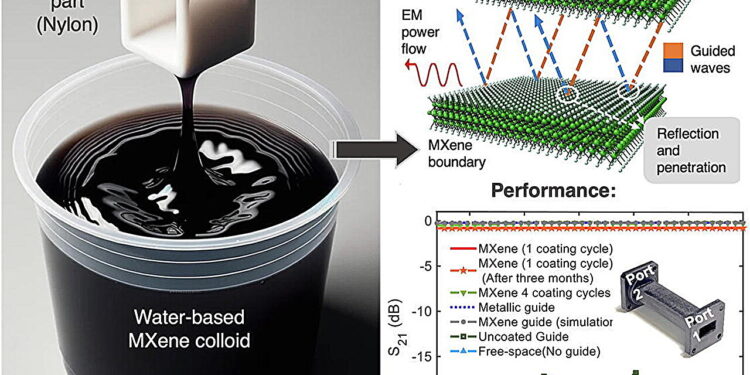Graphical summary. Credit: Materials today (2024). DOI: 10.1016/j.mattod.2023.12.013
One of the most important components of satellites enabling telecommunications is the waveguide, which is a metal tube intended to guide radio waves. It is also one of the heaviest payloads that satellites carry into orbit. As with all space technology, reducing weight means reducing the amount of expensive, greenhouse gas-producing fuel needed to launch a rocket or increasing the number of devices carried by the same rocket into space.
Researchers at Drexel University and the University of British Columbia are trying to lighten the load by creating and testing a waveguide made from 3D printed polymers coated with a conductive nanomaterial called MXene.
In their article recently published in the journal Materials todaythe group reported the potential of using MXene coatings to impart electrical conductivity to lightweight, non-conductive components, a property sacrificed in additive manufacturing using polymeric materials, such as plastics.
“In spaceflight applications, every gram of extra weight counts,” said Yury Gogotsi, Ph.D., Distinguished University and Bach Professor in Drexel’s College of Engineering, a leader in MXene research. “MXene materials provide one of the thinnest possible coatings (their flakes are a few atoms thick) that can create a conductive surface. We therefore see great potential in using MXenes to process components manufactured in a additive based on polymers with complex shapes.”
Waveguides work like pipelines for microwaves. They direct waves to receivers while preserving signal strength. In a microwave oven, wave guides ensure food is heated; on a satellite, they transfer high-quality signals between different objects within and between satellites, as well as between satellites and Earth.
And, just like the complex network of pipes that snake through a house, waveguides are designed in different shapes to fit confined spaces. They can range from simple straight channels to structures as complex as a maze.
“Waveguides can be as simple as a straight, rectangular channel, or they can take on shapes resembling a ‘crazy straw,’ with bends and twists,” said Mohammad Zarifi, an associate professor who studies waveguides. microwave communication at the University of British Columbia and led the team’s electrical engineering and design efforts. “However, what really changes the game is the advent of additive manufacturing methods, which enable more complex designs that can be difficult to produce with metals.”
While any hollow tube can be used as a primitive “waveguide”, those that transmit electromagnetic waves (in microwave ovens and telecommunications devices, for example) must be made from a conductive material to preserve the quality of the transmission. These waveguides are typically made from metals like silver, brass, and copper. In satellites, aluminum is the lightest choice.
The Drexel researchers, who first discovered MXenes in 2011 and have led their research and development since, suggested that the 2D nanomaterials would be a good candidate as a coating for plastic waveguide components, on the based on their earlier findings that MXenes can block and channel electromagnetics. radiation.
“Our MXene coating emerged as a strong candidate for this application because it is highly conductive, functions as an electromagnetic shield, and can be produced simply by dipping the waveguide into MXenes dispersed in water,” said Lingyi Bi , holds a Ph.D. candidate in Gogotsi’s group. “Other metallic paints have been tested, but due to the chemicals used to stabilize their metallic ingredients, their conductivity suffers compared to MXenes.”
Additionally, researchers reported that the MXene coating adheres exceptionally well to 3D printed nylon waveguides due to the compatibility between their chemical structures. The team coated lightweight guides of different shapes and sizes (straight, curved, twisted, and resonator-shaped) to test MXene’s ability to completely cover their interiors.
MXene-coated nylon waveguides weigh approximately eight times less than the standard aluminum waveguides currently in use, and the MXene coating adds only a tenth of a gram to the total weight of the components.
More importantly, the MXene waveguides performed almost as well as their aluminum counterparts, showing 81% efficiency in guiding electromagnetic waves between two terminals after a single dip coating cycle, a drop of 2 Only .3% compared to the performance of aluminum. The researchers demonstrated that they could improve this transmission metric by varying the coating layers or the size of the MXene flakes, to achieve a maximum transmission efficiency of 95%.
This performance remained stable when the transmission was composed across the different frequency bands, such as those currently used in low Earth orbit satellite communications, and with sufficiently high input power for these transmissions. It also did not degrade significantly after three months, an indicator of the durability of the coating.
“MXene-coated waveguides still need to undergo extensive testing and be certified for space use before they can be used on satellites,” said Roman Rakhmanov, a doctoral student at Drexel who participated in the research. “But this discovery could be an important step toward the next generation of space technology.”
Gogotsi’s team plans to continue exploring MXene coatings in applications that could benefit from an alternative to metal components.
“These promising results suggest that MXene-coated components could provide a lightweight and viable replacement for waveguides used in space,” Gogotsi said. “We believe the coatings could also be optimized for variable frequency transmissions and applied to a variety of additively manufactured or injection molded polymer components, providing a lightweight, low-cost alternative to metals in a number of applications terrestrial as well. “
More information:
Omid Niksan et al, MXene guides microwaves through 3D polymer structures, Materials today (2024). DOI: 10.1016/j.mattod.2023.12.013
Provided by Drexel University
Quote: MXene-coated devices can guide microwaves into space and lighten payload (February 7, 2024) retrieved February 7, 2024 from
This document is subject to copyright. Apart from fair use for private study or research purposes, no part may be reproduced without written permission. The content is provided for information only.



